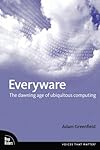Many people already knew this was happening, but for those that don’t — I am now officially a part-time university academic.
Now this does not mean I’m going to be a part-time academic, quite the opposite. The reason for moving to working part-time at the University is to give me freedom to do the things I’d like to do as an academic, but never have time. Including writing more, reading, and probably cutting some code!
Reading especially, and I don’t mean novels (although that would be nice), but journal papers and academic books. Like most academics I know, for years I have only read things that I needed to review, assess, or comment on — or sometimes in a fretful rush, the day before a paper is due, scurried to find additional related literature that I should have known about anyway. That is I’d like some time for scholarship!
I guess many people would find this odd: working full time for what sounds like doing your job anyway, but most academics will understand perfectly!
Practically, I will work at Lancaster in spurts of a few weeks, travel for meetings and things, sometimes from Lancs and sometimes direct from home, and when I am at home do a day a week on ‘normal’ academic things.
This does NOT mean I have more time to review, work on papers, or other academic things, but actually the opposite — this sort of thing needs to fit in my 50% paid time … so please don’t be offended or surprised if I say ‘no’ a little more. The 50% of time that is not paid will be for special things I choose to do only — I have another employer — me 🙂
Watch my calendar to see what I am doing, but for periods marked @home, I may only pick up mail once a week on my ‘office day’.
Really doing this and keeping my normal academic things down to a manageable amount is going to be tough. I have not managed to keep it to 100% of a sensible working week for years (usually more like 200%!). However, I am hoping that the sight of the first few half pay cheques may strengthen my resolve 😉
In the immediate future, I am travelling or in Lancs for most of February and March with only about 2 weeks at home in between, however, April and first half of May I intend to be in Tiree watching the waves, and mainly writing about Physicality for the new Touch IT book.






